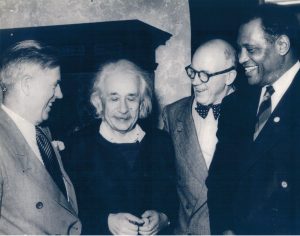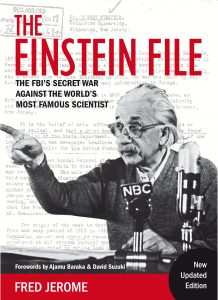By Rodger Taylor and Fred Jerome* (Listen to interview with Fred Jerome on Einstein’s anti-racism)
Einstein’s racist description of people he observed while visiting China and the Middle East in 1922 definitely needs to be reported and criticized {“Einstein Travel Diary Teems With Racism and Stereotyping” – New York Times, June 15, p. 9). There is no excuse for ignoring such racism—especially today as right-wing (“populist”) parties throughout Western Europe and Trumped-up U.S.A. are whipping up anti-immigrant racism—the old divide-and-conquer technique used so often by fascist parties in the past, showing again and again that a frightened population is an easily-controlled population. At the age of 42, Einstein certainly should have known better.
But the whole truth is a much bigger story that should receive—but so far has not received—at least as much media coverage as Einstein’s travel diary. Here’s a 4-question Einstein-quiz for readers and reporters (and editors) of the New York Times (and other papers that ran stories about Einstein’s travel diaries). They might help:
- True or False?: In 1937, when the great diva Marian Anderson was invited to give a concert at Princeton’s McCarter Theatre, but The Palmer House Hotel refused her a room, Einstein invited her to stay with him, his step- daughter and housekeeper. The great diva and the great scientist became good friends, and whenever she returned to Princeton she stayed at Einstein’s house on Mercer Street. (SEE: Marian Anderson’s autobiography “Lord, What A Morning!” )

From l. to r., Henry Wallace, Albert Einstein, radio commentator Frank Kingdon, and Paul Robeson at Einstein’s home in Princeton, October 1947.
- True or False? In 1946, a wave of lynching in this country, targeting especially black GI’s returning home from World War II, killed 56 African Americans. More than a million African Americans had risked their lives in the war to defeat fascism abroad and were now returning home, many to Southern States where fascism remained undefeated. (SEE: the movie “Mudville.”)
On July 27, 1946, the Times’ lead story reported: Georgia Mob of 20 Men Massacres 2 Negroes, Wives, One Was an Ex-GI. The next week, Einstein agreed to co-chair (with Paul Robeson) the American Crusade to End Lynching and to organize a protest in Washington, DC to demand a federal anti-lynching law. Thousands attended the Washington protest and a delegation met with President Truman in the White House. (Einstein‘s illness prevented him from traveling, but he sent a letter (with Robeson) to Truman.
- True or False? In 1951, when W. E. B. Du Bois was indicted by the Federal Government for “failing to register as a foreign agent,” Einstein publicly offered to be the first defense witness for the great historian. When Judge Mathew McGuire heard that, he looked around at the reporters from all over the world who were covering the trial, and then dismissed the case. (SEE: Du Bois biographies by Shirley Graham Du Bois and David Levering Lewis.)
- Select one: All of the above events were a) widely covered; b) partially covered; or c) not at all covered by the NY Times and most other mainstream media. (SEE: Reports on each of the above events in several African American newspapers.)
*Rodger Taylor and Fred Jerome, New York are co-authors of Einstein on Race and Racism, Rutgers University Press, 2005. Fred Jerome is also author of The Einstein File, The FBI’s Secret War on the World’s Most Famous Scientist published in a new updated edition with forewords by Ajamu Baraka and David Suzuki.
Einstein’s Egalitarian Political Vision Wasn’t Welcome in the USA: Featured Guest: FRED JEROME, author of the new updated edition of The Einstein File.
Description (30 minutes):
Albert Einstein is often portrayed as a fuzzy minded genius. But he was in fact a committed peace activist and champion of racial equality.
As such he befriended Paul Robeson, Marian Anderson and W.E.B. DuBois, and opposed the House UnAmerican Activities Committee.
For his principles and activity, he was stalked by the FBI. Jerome points out the Democrats and Republicans connived at trying to control Einstein.




Facebook